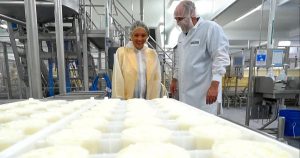
In east and central regions of the United States, the cream needed to make butter is more limited. The U.S. Department of Agriculture said the big driver of those new limits was increased domestic demand and access being slowed by a combination of inclement weather and limited drivers to transport the goods cross country.
Compared to last year, USDA reported the average price for a gallon of milk in December was $5.99, while it was $3.50 in 2020 in the Southeast region, including Florida. While prices for milk went up, supplies of cream to make delectable treats shrank. Even ice cream supplies were down by 1.7% compared to 2020. As of November, USDA reports the production of nonfat dry milk for human foods was down 15% in 2021, though it had risen compared to the month before.
Overall, the retail and food service demand for domestic butter supply is “steady to stronger” and export demand is healthy. Global supplies are tighter, according to the USDA, making bulk butter prices rise $0.07 to $0.18 above market prices.
The base price for a pound of butter in the U.S. is currently listed at $2.04 per pound, as of Jan. 3. Pricing is measured on a two-week average. In December 2021, pricing had ended at $1.91, according to USDA reports. A year ago, in January 2021, the price for a pound of butter was $1.46.
USDA reports part of the issue for butter production is the reopening of schools. “With the re-openings of schools and processing plants returning to production, butter operations holding sufficient in-house cream are running hard to replenish shrunken freezer inventory,” USDA said. “Butter plants with supplies not as available, limited churning is the rule, as those butter facilities prioritize in-house cream for contracted customers’ needs.”
Production facilities are reducing how much butter they’re making as domestic demand for butter increases in retail, food service and wholesale markets. Still, bulk butter stocks remain tight, particularly in the East, according to USDA.
The U.S. Midwest is seeing supplies of cream tighten, and the shortage of cream is hitting the supply of schmear for bagels and cheesecake, putting them on the hunt for ingredients to make their spread. “Cream cheese manufacturers are active in seeking cream,” USDA reported.
As a refresh on dairy pricing, cwt is how many dollars per hundredweight of milk. Milk is measured in how much 100 pounds of milk costs in dollars, which is what makes up a hundredweight. USDA is predicting the cost of Class III milk, used for making cream cheese and spreadable cheese futures to go up to $21.67 per cwt in February. Previously, USDA forecasted cwt to rise to $20.75 in January.
For coffee lovers who don’t love it enough to drink their coffee black, the milk used for making coffee creamer, Class I, will be up $0.54 per cwt, or a 2.45% increase from December. Class IV milk, used for making butter and condensed milk products, as well as dry milk, are expected to go up to $22.14 per cwt.
As far as high priority dairy products, USDA said cheese “continues to be high” on the list. The price for a 40-pound block of cheese, was up by $0.07 per pound, making it roughly $79.80 per block. Barrels of cheese, weighted at 500 pounds, also got more expensive, now priced $0.14 per pound higher for a total of $912.25 on average. Barrels and 40-pound blocks are the two standard supply sizes used by USDA.
Increased “logistical costs,” particularly feed for dairy cows, is reportedly impacting the production of milk on farms. Labor shortages are also reportedly contributing to dairy production and prices.
“Looking ahead, 2022 milk production is expected to continue to be lower than desired. Decisions will have to be made regarding allocating available milk among dairy products,” USDA reported. According to their report, “production and transportation challenges resulting from labor shortages; uncertainty related to COVID factors; and cost pressures” continue to make prices for common dairy products rise.























